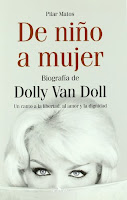Dolly was born and raised in Turin. When she grew up she went to Paris, and eventually got taken on at Madame Arthur and then Le Carrousel. Her first love was with a man who told her that he was a baron. After he found that she was pre-op, he left her, but came back after a few days, and the affaire continued for almost five years. Also in Paris, she came to know Josephine Baker and Amanda Lear. Salvador Dali, a frequent visitor to Madame Arthur, especially liked to see a Dolly Van Doll show.
She had completion surgery from Dr Burou in Casablanca in 1964. She arrived without an appointment. The price was 1,200 Francs, but she had only 600. “I cried and despaired so much that they gave me the missing half.” (Barba p 364). Her off-stage name became Carla Follis. She was the first known Italian to have had the operation, and as with Coccinelle the Church re-issued her baptismal certificate in her new name. However it took another year to get all her papers changed.
She did six years in cabaret in Berlin. In 1969 she fell madly inlove with a man who worked at Siemens. When the affair ended in 1971, she was hurt and took the first contract that came along – six months in Barcelona, even though she did not know where Catalonia was.
She arrived in Spain during the final years of the Franco dictatorship. Despite initially not speaking Spanish, and being assigned to a rather dingy nightclub, her talent and beauty filled the place every night. She was soon transferred to Barcelona de Noche, and became treated as a star. In 1973 Coccinelle came from Paris to perform with her. In 1974 she put on a show called Travesti with renowned comedian Alfonso Lusson.
She met the love of her life, Fernando. He took her all over Catalonia. They became partners.
Under the Franco dictatorship, sexual expression was repressed. “A vedette [star] would show a little piece of nipple and men would flock like flies; if two little hairs stuck out of the top of her panties, people would run to see her”. (Barba p368)
When Franco died in November 1975, Carla and Fernando were starting a month’s vacation in Sri Lanka. When they returned, things were already changing. Drag and even nudity were becoming visible, and Dolly realised that her act had become old-fashioned and it had to be revamped. She did so and then did a tour all over Spain.
In 1976 she and her partner Fernando moved to Valencia to open their own venue, Belle Époque. They married shortly afterwards, and she stayed in Catalonia the rest of her life. Dolly was a businesswoman as well as a performer. She travelled to Tokyo, Paris and Berlin, observed kabuki, cabaret, lyric theatre and incorporated them into her show. In 1982 they opened a second Belle Époque in Barcelona. Her shows were broadcast on Catalan television as part of the New Year’s Eve gala. In 1988 she was in the film Entreacte, which was partly filmed at the Belle Époque. Shortly afterwards the Valencia venue was closed. The Barcelona one ran until 1995.
Carla and Fernando later divorced, but remained good friends.
In 2007 her biography, From a boy to a woman, by Pilar Matos was published.
- Pilar Matos. De Niño a Mujer. Biografía De Dolly Van Doll. Arcopress Ediciones, 2007.
- Stan Lauryssens. Dali & I: The Surreal Story. Thomas Dunne Books, 2008: 31.
- Dolly Van Doll. “Dolly Van Doll, Turin, 1938” in David Barba. 100 españoles y el sexo. epublibre, 2009: 364-370.
- Valeria Vegas. “Dolly Van Doll” in Liberate: La Cultura LGBTQ que Abrio Camino en España. epublibre, 2020: 91-4.
- Luis Fernando Romo. “Dolly Van Doll: ‘Lo peor que me ha pasado es ser vecina de los Pujol’ ”. El Mundo, 26 enero 2020. Online.
- “Dolly van Doll, pionera de la transsexualitat”. Betevé, 3 de maig del 2021. Online.
------------
Most sites translate De Niño a Mujer as From a child to a woman. While the Spanish word for a boy is chico, the word Niño is a male child and Niña is a female child. Surely the point of the book title is a boy becomes a woman, not that a child becomes an adult.
Dolly gives the name of the 'baron' in Paris. I googled it to no effect.



No comments:
Post a Comment
Comments that constitute non-relevant advertisements will be declined, as will those attempting to be rude. Comments from 'unknown' and anonymous will also be declined. Repeat: Comments from "unknown" will be declined, as will anonymous comments. If you don't have a Google id, I suggest that you type in a name or a pseudonym.